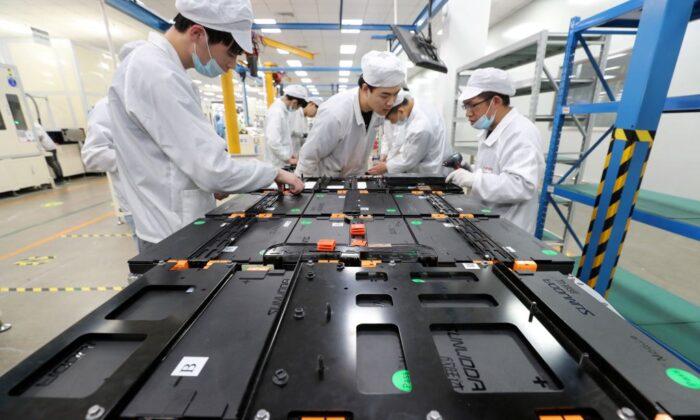The price of lithium carbonate, the key material used to make electric car batteries, has continued to skyrocket, tripling in the past year.
The valuable mineral is mainly processed in communist China, which has a monopoly on the battery market.
Lithium carbonate prices in China hit $71,315 a ton on Sept. 16, according to data from Asian Metal Inc.
This has caused a rise in the cost of lithium batteries, which has been increasing due to strong demand and lockdown disruptions at China’s main production hubs.
However, the current price hikes for the strategic mineral are likely to raise inflation concerns and add more cost expenditures to the supply chain.
A two-week power shortage back in August in China’s Sichuan Province, which is the source of one-fifth of the nation’s lithium production, has hampered supply in an already tight market.
Western governments have been leading an accelerated push for these so-called green electric powered vehicles, as those nations aim for a transition away from traditional sources of energy.
Dealing With Logjams
The Chinese Communist Party (CCP), according to Bloomberg, held a policy review meeting on Sept. 15 to address the logjams at the lithium facilities.Party officials from the Ministry of Industry and Information Technology, asked China’s top lithium producers to stabilize prices.
Producers were ordered not to collude on pricing and avoid quote prices that widely deviate from costs, said the ministry.
The communist regime said it will take further steps to encourage exploration, stabilize imports, and promote recycling to save on costs.

Analysts are saying that a reduction in battery output from China, could slow the growth in EV rollout globally, as price increases would trickle down to EV costs.
Soc. Quimica & Minera de Chile SA (SQM), the world’s second-largest lithium producer, said that it predicted a “very tight market” in the coming years.
SQM predicts that prices will be slightly in the third quarter from the previous quarter and expects them to be similar in the fourth quarter, according to a presentation to investors on Sept. 15.
China’s top battery producer, Ganfeng Lithium, told its customers last week that prices for new orders would likely face a substantial hike due to issues with lithium supplies.
Finding China Alternatives
Due to Chinese lithium shortages, battery and automobile manufacturers have been rushing to secure alternative reliable and stable supplies of lithium.The largest suppliers of lithium carbonate are Australia at, 323,000 tons, followed by Chile at 145,000 tons, Argentina at 30,000 tons, and China at 8,000 tons.
There are several projects throughout North America, Australia, and the European Union to further produce more supplies of the raw mineral.
Australia, opened production at a new processing site earlier this year, while Albemarle Corp., the world’s top lithium producer, is constructing a new refinery in the southeast United States.
One of the key provisions in U.S. President Joe Biden’s Inflation Reduction Act, sets aside almost $400 billion for spending on renewable energy, including lithium production.
The White House plans to have 2,300 grid-scale battery plants installed by 2030 and give EV makers tax breaks if they use certain components like batteries that are made in the United States.
The United States once supplied 27 percent of the world’s lithium back in 1996, but it fell to 1 percent in 2020, according to BP’s Statistical Review.
Only one lithium mine in the United States remained open as recently as two years ago.

Last week, Tesla, the EV manufacturing giant, announced plans to build a lithium refinery in Texas with the help of local tax breaks.
In April, Tesla’s CEO, Elon Musk, stated on an earnings call, that lithium production is essential for the future of the industry and that entrepreneurs should get into the mining business.
“Right now, we think mining and refining lithium… appears to be a limiting factor, and certainly is responsible for quite a bit of cost growth in sales,” said Musk, who explained. “I think it’s the single biggest cost growth item right now.”





